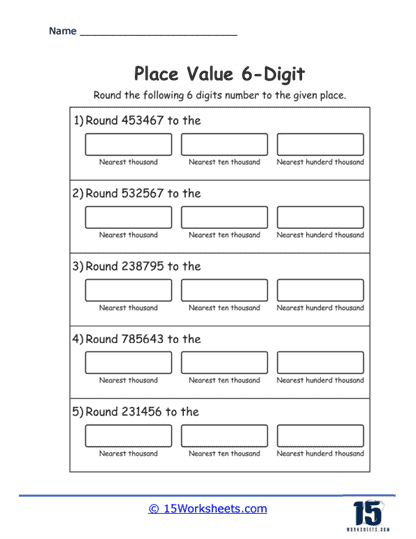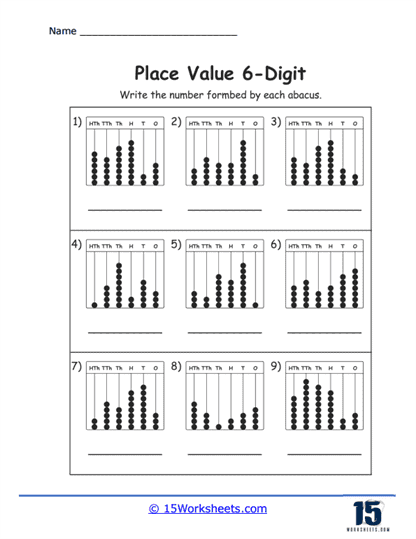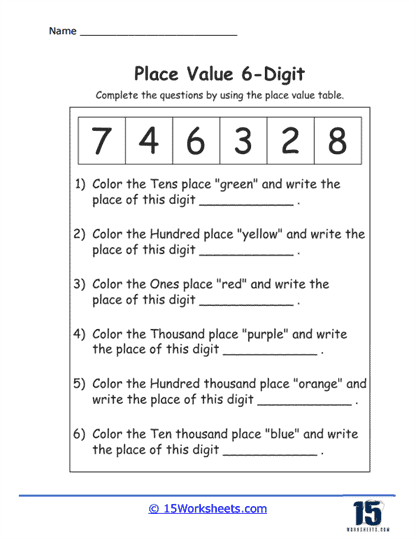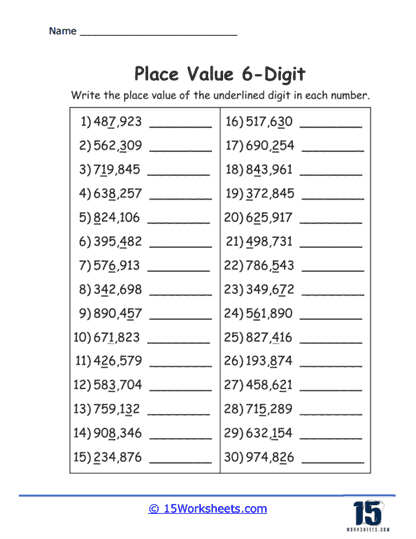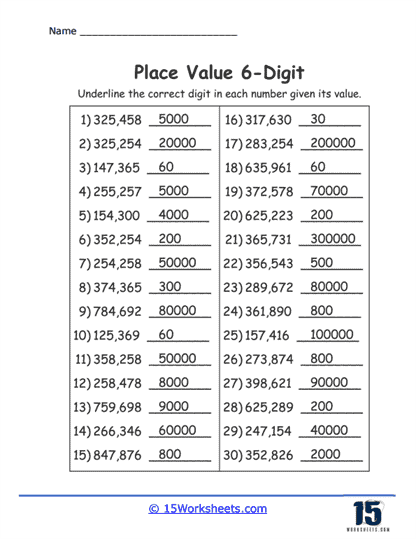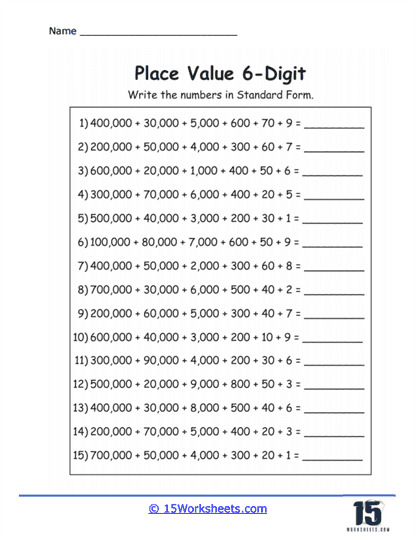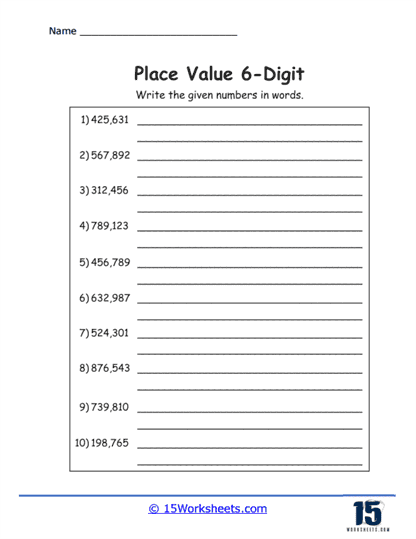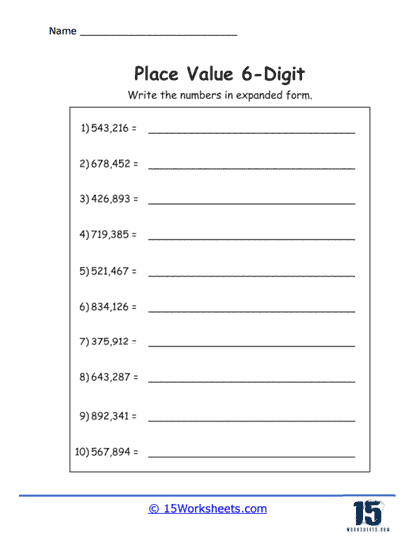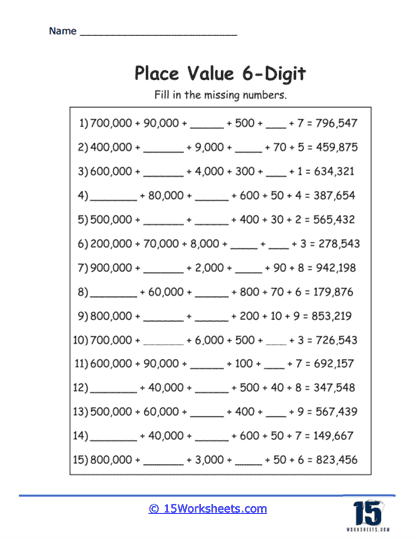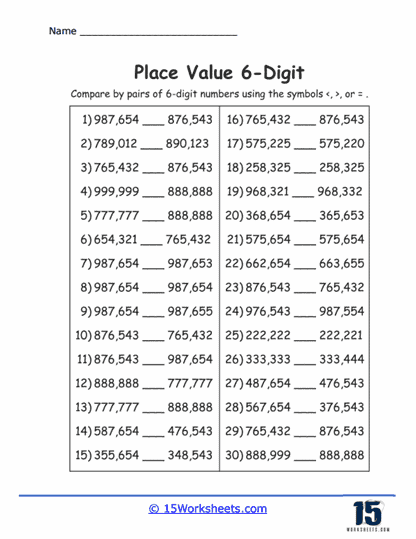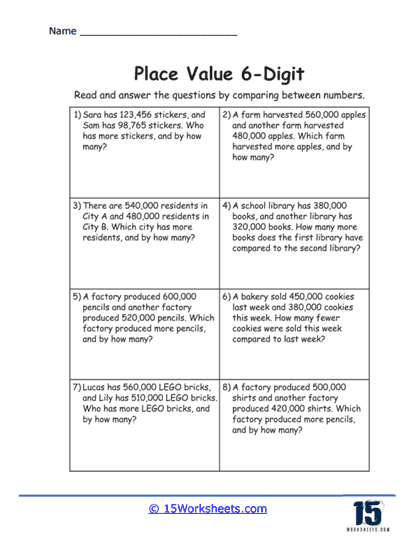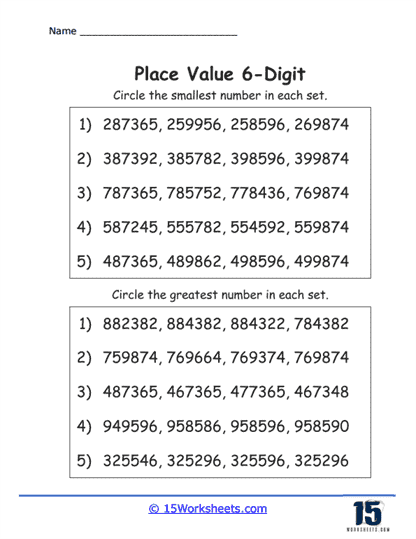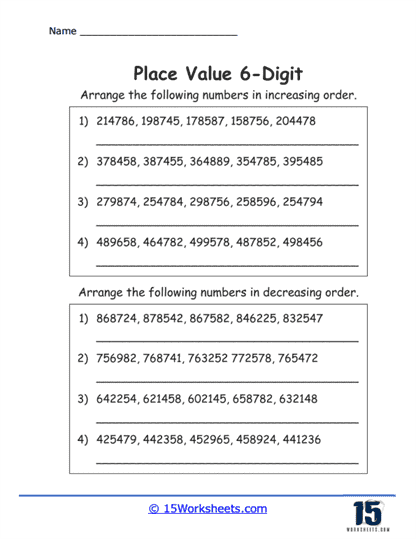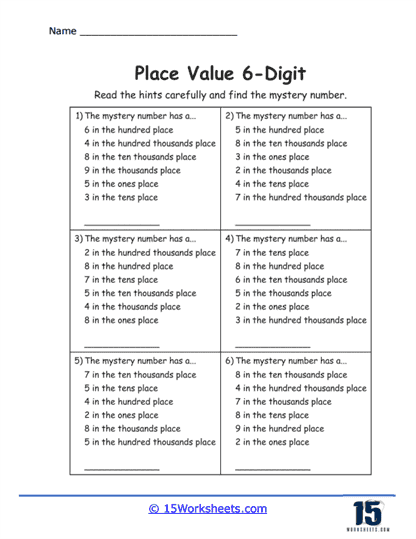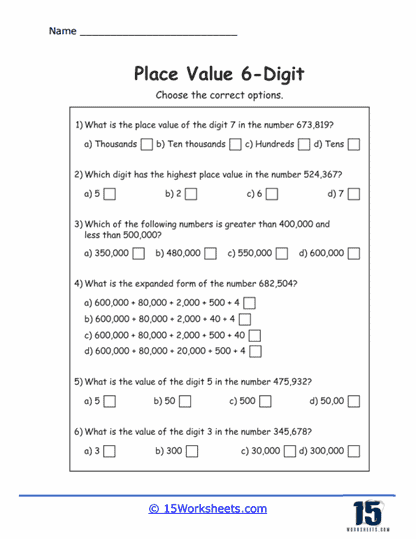6-Digit Place Value Worksheets
About These 15 Worksheets
These worksheets will help students grasp the concept of place value within large numbers, specifically focusing on numbers with six digits. These worksheets engage students in various activities that deepen their understanding of how each digit in a number contributes to its overall value, depending on its position. Mastering place value is a critical foundational skill in mathematics, as it supports more advanced operations such as addition, subtraction, multiplication, and division with large numbers. Let’s dive into the different types of 6-Digit Place Value worksheets and explore the specific math skills that each type helps to develop.
Understanding Place Value in Large Numbers
One of the fundamental types of activities you’ll find in 6-Digit Place Value worksheets is focused on identifying the place value of digits in a number. These exercises typically present students with a six-digit number where one digit is underlined, and students are asked to write the place value of the underlined digit. For instance, if the number is 487,923 and the digit 4 is underlined, students need to recognize that 4 is in the hundred thousand place, so its value is 400,000.
This type of exercise is crucial because it reinforces the concept that the value of a digit depends on its position within a number. By practicing with different numbers and different digits underlined, students learn to quickly identify whether a digit represents units, tens, hundreds, thousands, ten thousands, or hundred thousands. This foundational understanding is key to performing operations with large numbers and is often revisited in more complex mathematical concepts.
Comparing and Analyzing Large Numbers
Another important skill developed through these worksheets is the ability to compare large numbers. Worksheets often include exercises where students are given two or more six-digit numbers and asked to determine which is larger or smaller. Some worksheets may go further by asking students to explain how much larger one number is than another.
For example, a worksheet might present the scenario where a farm harvested 560,000 apples and another farm harvested 480,000 apples, asking students to determine which farm harvested more and by how many apples. These comparison exercises teach students not only how to determine the relative size of numbers but also how to perform subtraction to find the difference between two large numbers. This is a practical skill that students will use in real-life situations, such as understanding quantities in financial contexts or comparing data in science.
Breaking Down Numbers into Expanded Form
Understanding numbers in their expanded form is another key component of these worksheets. These activities require students to decompose a six-digit number into its individual place values and then express it as a sum of these values. For example, the number 796,547 can be broken down into 700,000 + 90,000 + 6,000 + 500 + 40 + 7.
This type of exercise helps students see the number as a combination of its parts, making it easier to understand how each digit contributes to the overall value of the number. It also lays the groundwork for more complex arithmetic, such as addition and subtraction of large numbers, by reinforcing the idea that numbers can be broken down and manipulated at the place value level. This expanded form is a critical step in helping students transition from basic arithmetic to more advanced mathematical concepts.
Writing Numbers in Words
Another common activity in these worksheets is writing six-digit numbers in words. This exercise asks students to convert numerical representations of large numbers into their word forms. For instance, students might be given the number 425,631 and asked to write it out as “four hundred twenty-five thousand six hundred thirty-one.”
This skill is important for several reasons. First, it ensures that students understand the structure of large numbers and how they are read. Second, it helps students develop their ability to communicate mathematical ideas clearly and accurately in both written and spoken form. Finally, it reinforces their understanding of place value by requiring them to think about how each digit and place value combine to form the entire number.
Ordering Numbers
Worksheets also include exercises that involve arranging a series of six-digit numbers in increasing or decreasing order. For example, students might be asked to arrange the numbers 214,786, 198,745, 178,587, 158,756, and 204,478 in ascending order from smallest to largest.
These exercises teach students how to compare multiple numbers at once and develop their ability to think critically about the relative size of numbers. Ordering numbers is a skill that is fundamental to many areas of math, from basic arithmetic to more advanced topics like statistics and probability. It also helps students develop their number sense, or their intuitive understanding of numbers and their relationships.
Rounding Large Numbers
Rounding is another crucial skill that is often covered in 6-Digit Place Value worksheets. Students might be asked to round a six-digit number to the nearest thousand, ten thousand, or hundred thousand. For example, they might need to round the number 453,467 to the nearest ten thousand, which would result in 450,000.
Rounding helps students simplify large numbers, making them easier to work with in both mental math and written calculations. It’s a practical skill that’s used in everyday situations, such as estimating costs, distances, or quantities. By practicing rounding, students become more comfortable with making approximations and understanding when and how rounding is appropriate.
Using Visual Representations
Some the worksheets use visual aids, such as an abacus, to help students understand large numbers. In these activities, students might be shown an abacus with beads representing each place value, and they are asked to write the number that the abacus represents.
This visual approach is particularly helpful for students who are visual learners, as it allows them to see a physical representation of the abstract concept of place value. It also reinforces the idea that each place value is a different “column” in the number, much like the columns of an abacus. This connection between a physical object and an abstract idea can help students internalize the concept of place value more deeply.
Mystery Numbers and Problem-Solving
Some worksheets take a more engaging approach by turning place value into a problem-solving activity. For instance, a worksheet might present a series of clues about a “mystery number” and ask students to figure out what the number is. The clues might include statements like “The mystery number has a 6 in the hundred thousands place and a 4 in the tens place.”
These types of activities are great for encouraging critical thinking and problem-solving skills. They require students to use their knowledge of place value in a more creative and investigative way, making the learning process more interactive and enjoyable. This type of exercise also helps students develop their ability to follow a logical sequence of steps to arrive at a solution, a skill that is valuable in all areas of mathematics.
Multiple-Choice Questions and Assessments
Some of these worksheets include multiple-choice questions that assess students’ understanding of place value. These questions might ask students to identify the place value of a particular digit in a number, to choose the correct expanded form of a number, or to determine which number has the highest or lowest value.
These assessment-style questions are important for gauging students’ understanding and for identifying areas where they might need additional practice. They also prepare students for standardized tests, which often include questions about place value. By practicing with multiple-choice questions, students can become more comfortable with this format and improve their test-taking skills.

